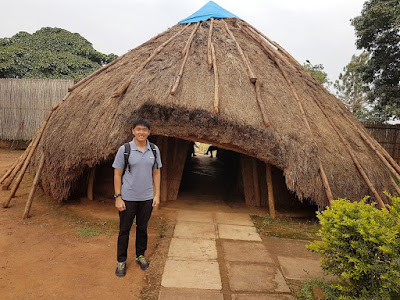Near Doha Port, Doha, Qatar
Sat-Thu: 9.00am - 7.00pm
Fri: 1.30pm - 7.00pm
Located on the southern end of Doha Corniche is Museum of Islamic Art, which is built on an island off an artificial projecting peninsula near the traditional harbour. Established in late 2008, the five-storied museum houses permanent and temporary exhibitions, and it has got its own park.

It was an easy walk for my BFF and me to reach there from
The Royal Riviera Hotel.
 |
| Look at that symmetry! |
 |
| The museum has got a blocky architecture, which appears quite unique. |
The museum occupies a total area of 45,000 square metres. Admission is free of charge for locals and foreigners alike.
 |
| Beautifully written inauguration statement by Sheikh amad bin Khalifa Al Thani~ |
 |
| Symmetry lovers will certainly appreciate the interior of the museum. |
 |
| MIA Café offers light bites, but the prices are pretty expensive. |
I guess the UV radiation is always strong in Qatar, but do take some time to take a look at the breathtaking views of the surroundings from the open areas of the museum.
 |
| There are lots of traditional boats around. |
Zoom in on the panorama shot below.
We found a quieter spot to view the city skyline.
 |
| I suspect that part of the building is where the library is. |
 |
| I'll write more about the steel '7' Sculpture in a separate post on MIA Park. |
At the point of writing, the museum holds a temporary exhibition on Syria from 22 November 2018 to 30 April 2019.
 |
| It's really sad to see some of those structures of historical significence being reduced to rubble. |
The rest of the post shall cover some of the objects that we saw in that temporary exhibition hall. Photography is, in general, allowed inside the museum. However, there are some objects that you can't take photos of.
 |
| Don't forget to take a printed guide near the entrance (not shown). |
 |
| They look like two happy men to me. |
The first section is on Ugarit, an ancient port city located somewhere in northern Syria. It was a flourishing coastal city, which was at its height from around 1450 BC until its destruction in approximately 1200 BC.
 |
| Believe it or not, it's an axe depicting a goddess on each side. |
 |
| Such an exquisite ancient bowl! |
 |
| On the left is an archer and on the right is a man with a boomerang. |
Let's move on to Palmyra, a desert city that dates back to the Neolithic period.
 |
| The city played an important role in trade. |
 |
| Those are some reliefs from sarcophagi. |
 |
| Seen in the painting by Louis-Francois Cassas are uniquely-shaped tower bombs in Palmyra. |
There are indeed many interesting objects that can be seen.
 |
| There are some coins from the Umayyad Caliphate (660-750) on display. |
 |
| Here's a passage from one of the Qurans found in 750. |
 |
| An astrolabe is an object used to measure the altitude of a celestial body above the horizon. |
Qal'at Salah ad-Din witnessed the hostile encounters during the Crusades, a series of religious wars between Christians and Muslims, in Syria.
These two objects depict Christian figures and saints, testament to the influence of Christianity in the 13th century.
Had enough of ancient objects? The last part of the exhibition features local produce and cultural items.
 |
| You may want to smell the aromas of the various spices. |
 |
| What a big robe! |
 |
| How do you find the elaborate carving on the gate? |
There's a wall where you can write messages for ailing Syria. I'm certainly glad that the Islamic State is losing. The world doesn't have a place for such a wicked terrorist group that's clearly the antithesis of Islam.
Do look forward to Part 2, which shall feature collections inside the permanent exhibition halls.





































































































Comments
Post a Comment